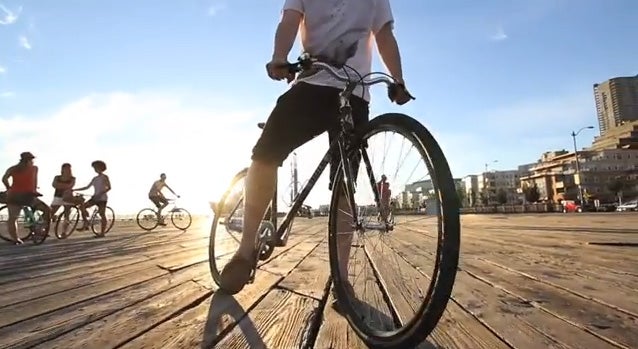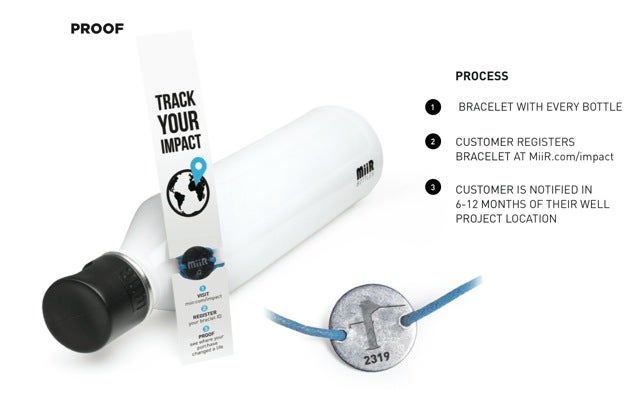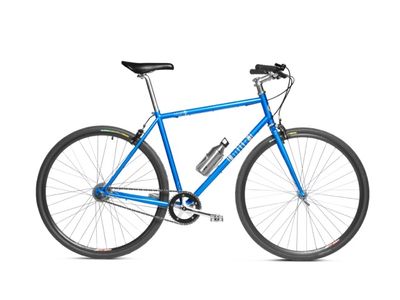
Bryan Papé believes that a bike is more than just a frame, two
wheels, and a bunch of components. He sees the bicycle as an instrument of
social change. “After clean water and sanitation, one of the biggest
impediments to economic development in Africa is transportation,” Papé says.
“Kids can’t get to school. People can’t get to market to sell their goods. And
the simplest, most affordable solution is bicycles.”
For every bike sold
through Papé's two-year-old company , another bike is donated to someone in
need. The program, called One4One, began with
Miir’s first product, water bottles. One dollar from each bottle sold—which
Papé says is enough to provide clean water for one person for a year—supports
well projects in developing countries. “The starting point for the company was
to make a great product and build a sustainable business,” Papé says. “Once we
realized we could do that and we put in place a model that can support itself,
then we turned our attention to taking some of what we were making and giving
it back. Looking at the problems out there like clean water and lack of
transportation, and seeing how easily they can be solved, I just feel it’s
important to try and do a part.”
We chatted with Papé from Miir’s Seattle, Washington,
headquarters about how the program works, the cost of clean water, and why he
believes that everyone who wants a bike should get one.
How did you get into
this?
Before Miir, I was minority in , which
makes hand warmers. We took Little Hotties from being a company of five people to a
company of hundreds, and after we sold the company in 2009 I was looking for
a new challenge. Around that time, I was at REI testing facilities here in
Seattle testing hand warmers, and they had all these water bottles lying around
that they were testing, too. I struck up a conversation with some of the guys
there, and they were telling me, “Nobody has a great design for water bottles.” I didn’t realize it then, but that’s how I got started with Miir and making
bottles.
So what sets Miir bottles
apart?
When we began this project in 2009,
there weren’t a lot of bottle companies out there. That has changed in the last
few years, but when we started, the options were limited and the features on
many of the bottles were basic. So with Miir, we concentrated on very simple,
clean design. We wanted a bottle that fits into cup holders. The bottles have fewer
threads than most, so one twist and it’s open. The opening is just the right
size for drinking: big enough for ice, but not so big that it gives you a water
beard when you drink. Even the shape is optimized. The shoulders aren’t abrupt
but are more like a wine bottle for smoother pouring.

Where does the give back component come in?
A lot of water bottle companies are based on good ideas—don’t buy single-use bottles; plastic is bad—but the messaging is negative. I wanted Miir to have a positive outlook. Around that time I came across , a not-for-profit out of New York, and I learned that almost a billion people in the world don’t have access to clean water. Charity Water didn’t just present this problem, though; they had solutions. When I realized how little it takes to give access to clean water—that $20 can buy a person clean water for 20 years—I decided that was going to be our message and our cause. It’s not about “Don’t do this,” or “Don’t do that.” It’s about doing something about a problem by simply purchasing a great product. And we made it really simple. One dollar from every bottle goes to clean water projects.
With the scandals
surrounding Lance and LiveStrong and Greg Mortenson’s Central Asia Institute,
there’s definitely more skepticism now about charities. How can people know
that their money is being used effectively and how you say it’s being used?
Every bottle comes with an individual tracking bracelet, and
you go online and register that bracelet after you buy the bottle. Then, in six
to 12 months, Miir will send you an email with a locator that shows the
well project that the money from your bottle has gone to fund. There’s a
map and pictures of the well. We’re all about transparency and showing
people what we’re doing.
So how did you go
from bottles to bikes?
I went to Liberia to see some of the well projects we were
working on firsthand. Being over there in Africa, I learned about people’s
needs beyond just clean water and sanitation. We were asking everyone what else
we could do, what they needed. And one theme that kept coming up over and over
again was the lack of transportation. People told us they couldn’t sell their
goods because it took them too long to walk to the market. They said their
children didn’t go to school because they had no way of getting there. Seeing
that firsthand was pretty much what lead to the bike project. I was asking, “What
else can make a difference?” And the answer was bikes. The bike is the most affordable
form of transportation.
How does the bike
program work?
I got connected with Kevin Menard from , and
he has been so helpful in getting this off the ground. He did a lot of
the design work, and he helped us with sourcing from Taiwan. We’re selling
of bikes right now—a single speed, a five speed, and a mixte.
They cost between $700 and $900. And for every bike we sell, we pay to purchase
one bike, either through in Africa or in the U.S. through
the . Giving a bike in Africa costs $134. It’s less in the
U.S.—between $70 and $90 per bike—because it’s a co-op model that fixes up old
bikes. We split the donations 50/50 between international and domestic
because while it’s sexy to say that you’re giving bikes in Africa, there's a bit
of a stigma about giving domestically. And we feel it is just as important to help
provide bikes to the homeless and immigrants and others who can’t afford bikes in this country.
So you just give the bikes away?
No, it’s really important to us that we don’t just provide
handouts. We have study-to-own and work-to-own contracts with both partners so the
recipients earn the bike over time through work or performance. We've learned
that ownership gets people vested in what they are doing and leads to
sustainability.

Miir bikes aren’t
expensive, but they aren’t exactly cheap either. I assume that’s because the
price includes the second bike to be donated?
We could make cheaper bikes and sell them to consumers for
less, but we’re committed to making great bikes. Our bikes are well made and
are going to last. We source high-quality bearings and parts. The tubing is
really good, and the welds are solid. And there are extra perks like baskets and
bottles. We’re definitely not competing with the total budget companies, but
we’re competitive with other comparable bikes from brands like Trek, Linus, and
Felt. We have to make sure that we’re not just tacking the cost of our give
onto the cost of our product. If you were to buy a comparable bike
to what we sell and donate a bike through World Bike Relief, it would cost you
more than buying a Miir.
I see on the site that bikes are going for $1,000 right now?
That's a special going on right now to become part of the . For the extra money, you get a hand-numbered frame with a special edition head badge that signifies that you got in on the ground floor. You also get a co-branded Chrome bag and some other bits and pieces. Pricing will revert to normal retail prices after the first of the year.
What does the name
Miir mean?
One of our inspirations was John Muir, the naturalist and
environmentalist who did so much work in our National Park system. We wanted
that nod to the outdoor industry and the environment. Also, in Russian, the
world “mir” means world or peace. We melded these two things to make it intrinsically ours.
Why are you convicted about giving back?
My family has been in business for themselves forever, and
they’ve always been committed to giving back. I guess I just learned that
message of taking what you earn and giving a portion. I was reminded of that in
Liberia, where I met a man named Prince Kondoh. Prince is an entrepreneur who
works with a friend of mine's not-for-profit over there, but on the side he takes care
of 30 blind people. They sell furniture and baskets to subsist. Incidentally,
we’re working with him on a project to build bike baskets we can sell. Anyway, I
asked him one day, “How can you take care of 30 blind people?” It’s such a huge
undertaking, such a commitment. And his response was, “How can you not?”
How is Miir doing?
The response has been really good. We believe in the bikes,
and people seem to really like them. But it’s more than just products. Our bikes
and bottles can really impact other people’s lives, so when we can convey that
story to our consumers, they get really stoked. We’re not just making another
product to fill the shelves. We’re selling a message of hope and change. In the
end, that’s a really easy sell.
—Aaron Gulley